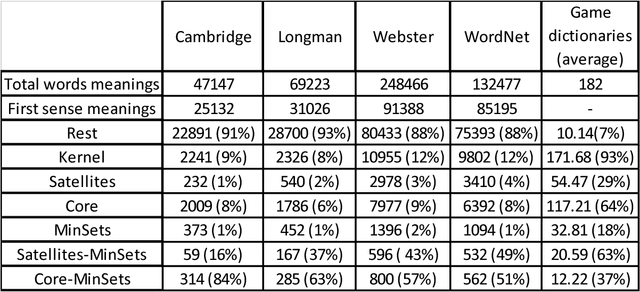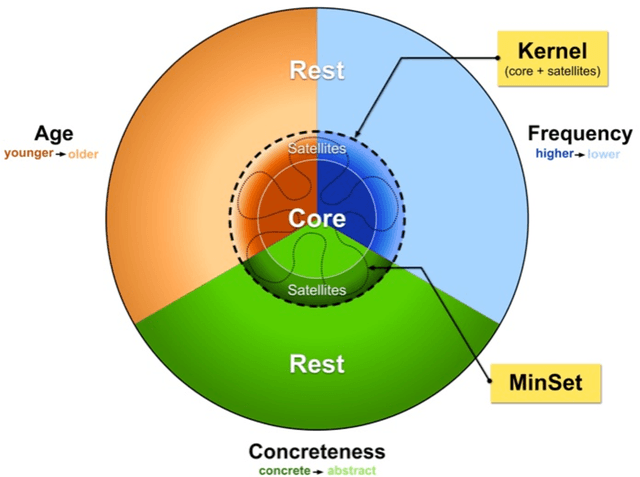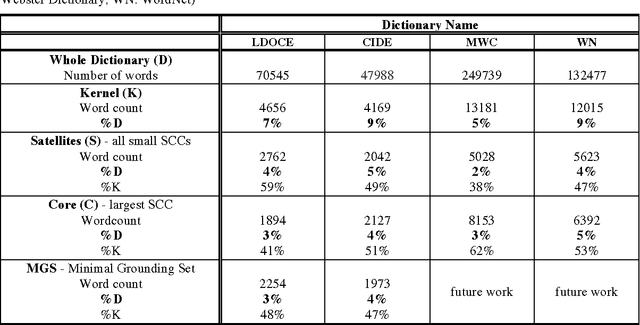Odile Marcotte
The Latent Structure of Dictionaries
Jan 22, 2016



Abstract:How many words (and which ones) are sufficient to define all other words? When dictionaries are analyzed as directed graphs with links from defining words to defined words, they reveal a latent structure. Recursively removing all words that are reachable by definition but that do not define any further words reduces the dictionary to a Kernel of about 10%. This is still not the smallest number of words that can define all the rest. About 75% of the Kernel turns out to be its Core, a Strongly Connected Subset of words with a definitional path to and from any pair of its words and no word's definition depending on a word outside the set. But the Core cannot define all the rest of the dictionary. The 25% of the Kernel surrounding the Core consists of small strongly connected subsets of words: the Satellites. The size of the smallest set of words that can define all the rest (the graph's Minimum Feedback Vertex Set or MinSet) is about 1% of the dictionary, 15% of the Kernel, and half-Core, half-Satellite. But every dictionary has a huge number of MinSets. The Core words are learned earlier, more frequent, and less concrete than the Satellites, which in turn are learned earlier and more frequent but more concrete than the rest of the Dictionary. In principle, only one MinSet's words would need to be grounded through the sensorimotor capacity to recognize and categorize their referents. In a dual-code sensorimotor-symbolic model of the mental lexicon, the symbolic code could do all the rest via re-combinatory definition.
Hidden Structure and Function in the Lexicon
Sep 16, 2013



Abstract:How many words are needed to define all the words in a dictionary? Graph-theoretic analysis reveals that about 10% of a dictionary is a unique Kernel of words that define one another and all the rest, but this is not the smallest such subset. The Kernel consists of one huge strongly connected component (SCC), about half its size, the Core, surrounded by many small SCCs, the Satellites. Core words can define one another but not the rest of the dictionary. The Kernel also contains many overlapping Minimal Grounding Sets (MGSs), each about the same size as the Core, each part-Core, part-Satellite. MGS words can define all the rest of the dictionary. They are learned earlier, more concrete and more frequent than the rest of the dictionary. Satellite words, not correlated with age or frequency, are less concrete (more abstract) words that are also needed for full lexical power.
* 11 pages, 5 figures, 2 tables
Hierarchies in Dictionary Definition Space
Nov 30, 2009



Abstract:A dictionary defines words in terms of other words. Definitions can tell you the meanings of words you don't know, but only if you know the meanings of the defining words. How many words do you need to know (and which ones) in order to be able to learn all the rest from definitions? We reduced dictionaries to their "grounding kernels" (GKs), about 10% of the dictionary, from which all the other words could be defined. The GK words turned out to have psycholinguistic correlates: they were learned at an earlier age and more concrete than the rest of the dictionary. But one can compress still more: the GK turns out to have internal structure, with a strongly connected "kernel core" (KC) and a surrounding layer, from which a hierarchy of definitional distances can be derived, all the way out to the periphery of the full dictionary. These definitional distances, too, are correlated with psycholinguistic variables (age of acquisition, concreteness, imageability, oral and written frequency) and hence perhaps with the "mental lexicon" in each of our heads.
 Add to Chrome
Add to Chrome Add to Firefox
Add to Firefox Add to Edge
Add to Edge